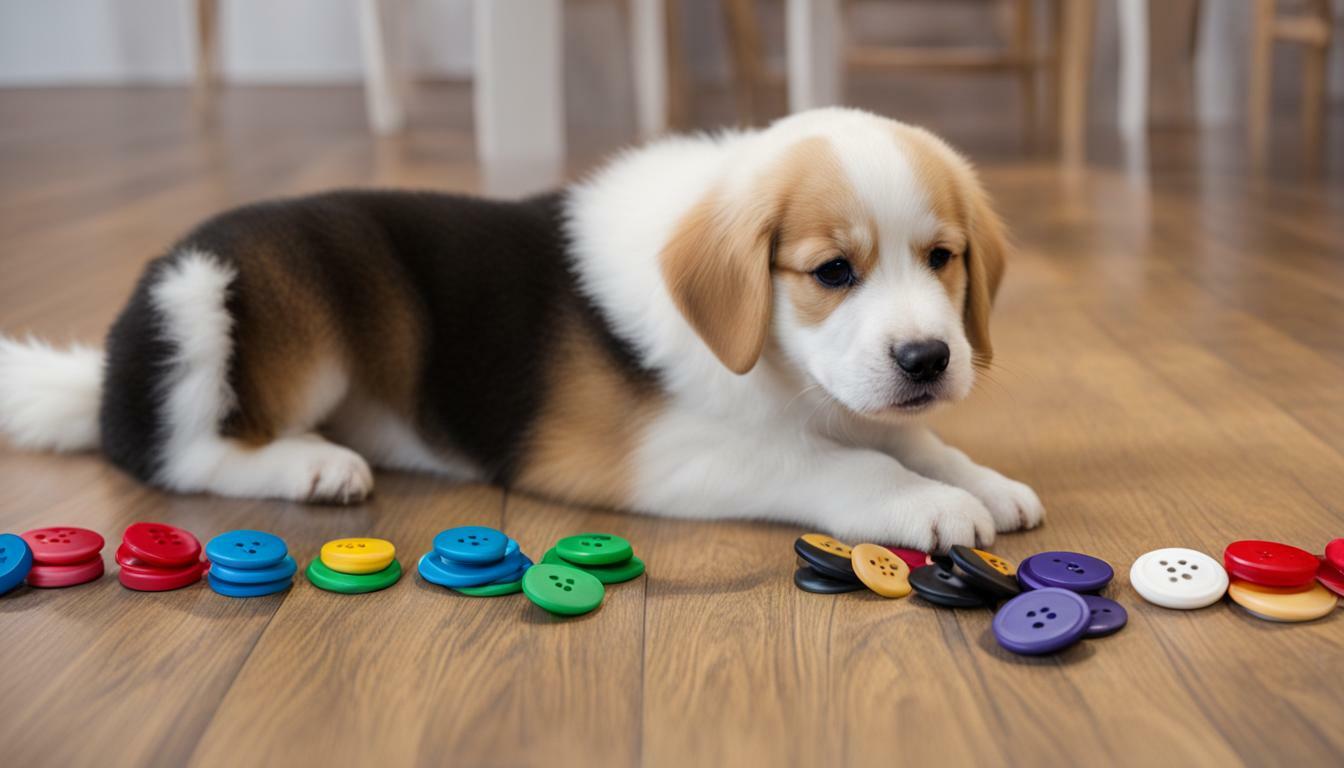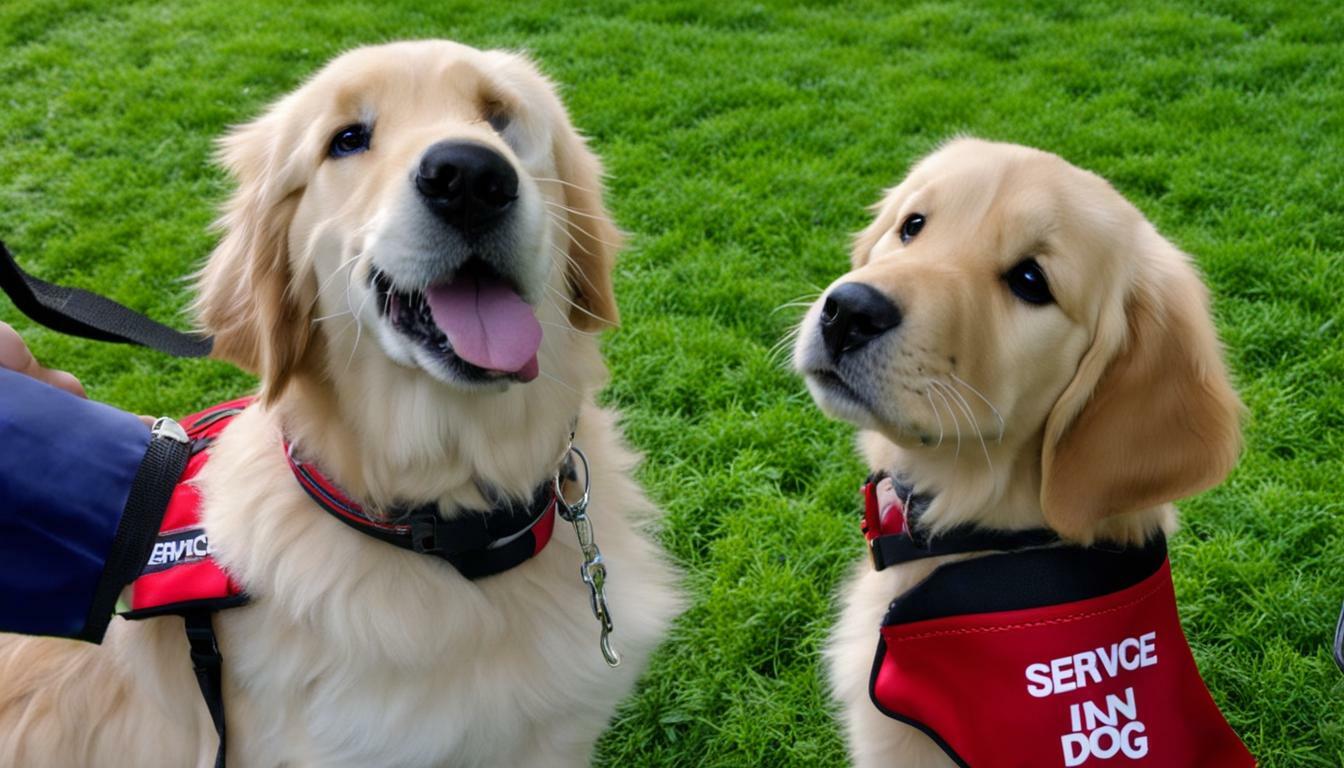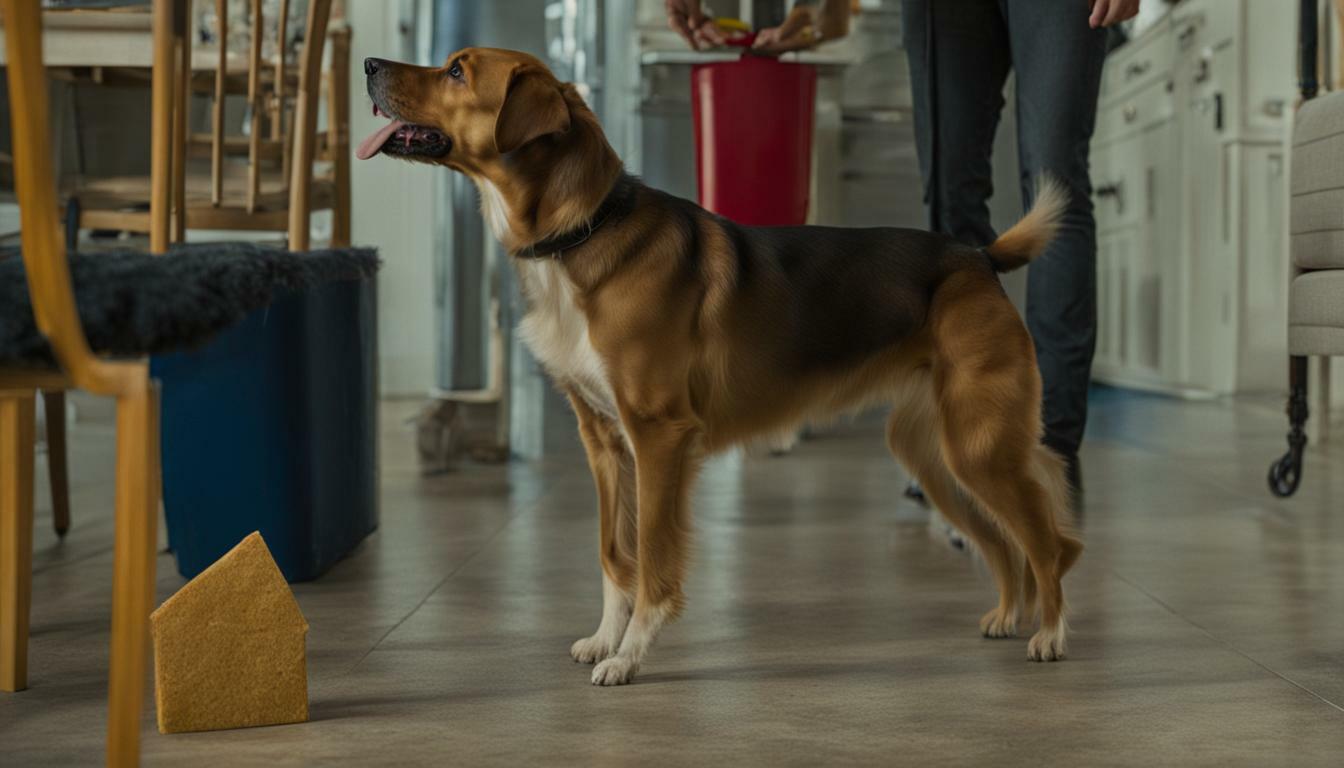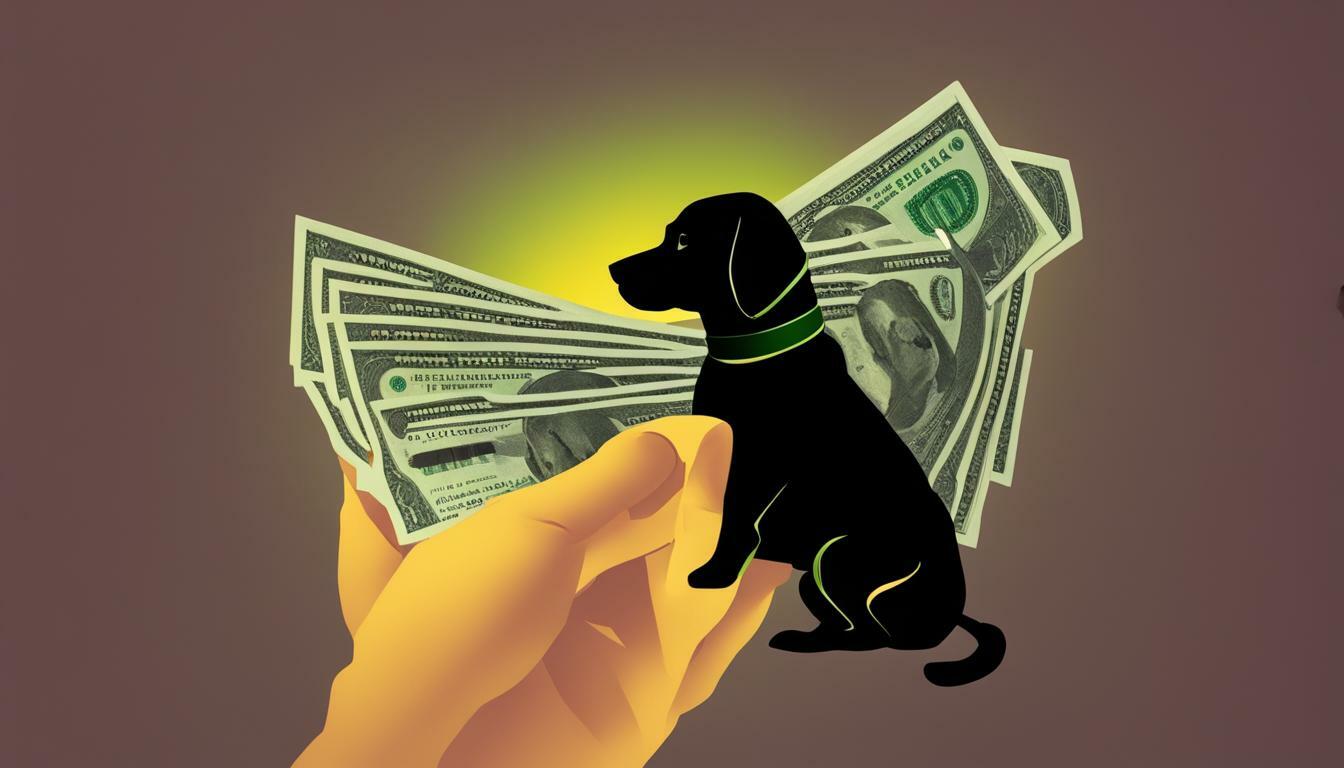Training a bully dog requires patience, consistency, and positive reinforcement. It is best to start training them at a young age, but it is never too late to begin. Reward-based training, such as clicker training, works well with bully breeds. It is important to have precise timing when using a clicker to mark desired behaviors. Training sessions should be short, fun, and varied to keep the dog engaged. Moist and flavorful treats are recommended for training. Basic commands such as sit, stay, and come should be taught and reinforced. Teaching social skills and potty training are also important for bully breeds. Crate training can provide a safe and comfortable space for the dog. Positive reinforcement should always be used, while negative reinforcement and punishment should be avoided. Consistency and patience are key to successful training.
Key Takeaways:
- Training a bully dog requires patience, consistency, and positive reinforcement
- Start training your bully dog at a young age, but it is never too late to begin
- Reward-based training, such as clicker training, is effective for bully breeds
- Keep training sessions short, fun, and varied to keep the dog engaged
- Use moist and flavorful treats to motivate your bully dog during training
Starting Training at a Young Age
To set your bully dog up for success, start training them when they are young. Training a bully dog requires patience, consistency, and positive reinforcement, and starting early can make the process much smoother. By beginning the training process at a young age, you can establish good habits and behaviors that will last a lifetime.
One of the best practices for training a bully dog is to train them like a pro. This means using proven methods that have been successful in training bully breeds. Reward-based training, such as clicker training, is highly effective. With precise timing, you can use a clicker to mark desired behaviors and reinforce them with rewards, ensuring your bully dog understands what behaviors are expected of them. This positive reinforcement approach creates a strong bond between you and your furry friend, making the training experience enjoyable for both of you.
When training your bully dog, remember to keep the sessions short, fun, and varied. Bully breeds can sometimes have a shorter attention span, so it’s important to keep them engaged throughout the training process. You can achieve this by incorporating games, toys, and different environments into the training sessions. This not only helps to stimulate their minds but also makes the training experience more enjoyable.
| Training Tips | Effective Techniques |
|---|---|
| Use positive reinforcement | Clicker training, rewards, praise |
| Keep training sessions short | 5-10 minutes, multiple sessions per day |
| Make training fun and varied | Games, toys, different environments |
Remember to always use moist and flavorful treats as a form of motivation during training. Bully dogs respond well to food rewards, and using tasty treats can help reinforce desired behaviors. Be sure to choose treats that are healthy and appropriate for your bully dog’s dietary needs. By using these treats effectively, you can teach your bully dog basic commands such as sit, stay, and come, which are crucial for their safety and well-being in various situations.
In conclusion, starting training at a young age, using positive reinforcement, keeping sessions short and engaging, and incorporating tasty treats are all proven methods for training a bully dog. By following these best practices, you can train your bully dog like a pro and establish a strong bond with them that will last a lifetime.
Reward-Based Training: Clicker Training
Reward-based training, such as clicker training, is highly effective for training a bully dog. This method uses positive reinforcement to mark and reward desired behaviors, making the training process enjoyable and engaging for both the dog and the owner. With precise timing, the clicker is used to indicate the exact moment the dog performs a desired behavior, followed by a treat or praise.
Clicker training is particularly beneficial for bully breeds, as it allows for clear communication and encourages their natural intelligence and problem-solving abilities. By consistently associating the sound of the clicker with rewards, the dog learns to repeat behaviors that yield positive outcomes.
To get started with clicker training, follow these steps:
- Introduce the clicker to your dog in a quiet and distraction-free environment. Click the device and immediately give your dog a treat to establish the connection between the clicking sound and a reward.
- Select a specific behavior you want to teach your dog, such as “sit.” When your dog naturally performs the behavior, click the clicker and immediately follow it with a treat. Repeat this process until your dog associates the action with the clicker.
- Gradually add a verbal cue, such as saying “sit” before clicking and treating. With consistent practice, your dog will begin to understand the verbal command and perform the behavior without the need for the clicker every time.
- Continue this process for other desired behaviors, always reinforcing them with the clicker and treats. Remember to keep training sessions short, fun, and varied to keep your bully dog engaged and motivated.
Advanced Training Methods for Bully Dogs
Beyond basic commands and behaviors, there are advanced training methods that can further enhance your bully dog’s abilities and overall behavior. These methods include agility training, scent work, and tricks. By introducing these stimulating activities, you can provide mental and physical exercise while deepening the bond with your dog.
Agility training involves teaching your dog to navigate through obstacle courses, enhancing their coordination, and confidence. Scent work taps into your bully dog’s powerful sense of smell, teaching them to find specific scents or objects. Tricks, on the other hand, allow you to showcase your dog’s unique talents and entertain others.
When employing advanced training methods, remember to break down each task into smaller steps and reward your dog’s progress along the way. With patience, consistency, and positive reinforcement, you can unlock your bully dog’s full potential and create a well-rounded canine companion.
| Benefits of Clicker Training | Methods for Advanced Training |
|---|---|
| Clear communication between dog and owner | Agility training |
| Encourages problem-solving abilities | Scent work |
| Enhances intelligence and obedience | Tricks and showmanship |
| Stimulates mental and physical exercise |
Engaging and Fun Training Sessions
Training sessions should be short, fun, and varied to keep your bully dog engaged. Balancing the duration of each session is important, as dogs have limited attention spans. Aim for sessions that are no longer than 15-20 minutes to prevent your dog from becoming bored or restless. Breaking up the training into multiple sessions throughout the day can also help maintain their focus.
Variety is key to keeping your bully dog interested in the training process. Incorporate different activities and exercises to keep them mentally stimulated. For example, you can alternate between teaching commands, agility training, and playing interactive games. This not only provides mental enrichment but also strengthens the bond between you and your bully dog.
Sample Training Session Schedule
| Time | Activity |
|---|---|
| 9:00 AM – 9:20 AM | Basic commands: Sit, Stay, and Lay Down |
| 10:30 AM – 10:45 AM | Agility training: Weave poles and jumps |
| 2:00 PM – 2:15 PM | Interactive game: Hide and seek with treats |
Remember to end each training session on a positive note, praising and rewarding your bully dog for their efforts. This will help create a positive association with training and keep them motivated for future sessions. By keeping the training sessions engaging and fun, you’ll be well on your way to training your bully dog like a pro!
Tasty Treats for Motivation
When training your bully dog, make sure to use tasty treats as motivation. Using moist and flavorful treats can be highly effective in reinforcing desired behaviors and encouraging your dog to learn. Bully breeds, like any dog, respond well to positive reinforcement, and treats can be a powerful tool in this process.
When selecting treats for your bully dog, opt for ones that are both delicious and healthy. Look for treats that are made with high-quality ingredients and are suitable for your dog’s dietary requirements. It’s important to consider the size of the treat as well, as you’ll want to be able to give your dog frequent rewards during training without overfeeding them.
During training sessions, be sure to use treats strategically. Pair the treat with the desired behavior and give it immediately after the dog performs the action correctly. This will strengthen the association between the behavior and the reward. As your bully dog progresses in their training, you can gradually reduce the frequency of treat rewards while still offering verbal praise and affection as positive reinforcement.
| Treat Name | Description |
|---|---|
| Chicken Jerky | Thin, chewy strips made from chicken meat |
| Peanut Butter Treats | Biscuits or training treats with the delicious taste of peanut butter |
| Freeze-Dried Liver | Crunchy pieces of freeze-dried liver, a high-value treat for many dogs |
Avoid using treats that are high in fat, sugar, or artificial additives, as these can be detrimental to your dog’s health. It’s always a good idea to consult with your veterinarian to ensure that the treats you choose are suitable for your bully dog’s specific needs.
Teaching Basic Commands
Teaching your bully dog basic commands is an important part of their training journey. These commands lay the foundation for good behavior and help ensure the safety of your dog and those around them. By following a few essential training steps, you can successfully teach your bully dog commands like sit, stay, and come.
First, it’s important to establish a positive and calm training environment. Find a quiet space with minimal distractions where you and your dog can focus. Use treats as rewards to motivate your dog and reinforce desired behaviors. Start with simple commands like sit, using a treat to guide your dog into the correct position. Once they are sitting, praise and reward them. Repeat this process until your dog understands the command.
| Command | Training Steps |
|---|---|
| Sit | – Hold a treat above your dog’s head – Move the treat back, causing your dog to naturally sit – As soon as they sit, praise and reward them – Repeat the process, gradually reducing the use of treats |
| Stay | – Start by having your dog sit – Raise your hand with the palm facing them, as if signaling to stop – Take a step back and say “stay” – If your dog stays in place, praise and reward them – Gradually increase the distance and duration of the stay command |
| Come | – Attach a long leash to your dog’s collar – Walk a few steps ahead and say “come” – Gently tug on the leash, encouraging your dog to come towards you – When they reach you, shower them with praise and rewards – Practice in different environments, gradually reducing the reliance on the leash |
Consistency and patience are key when teaching basic commands to your bully dog. Practice these commands daily in short, focused sessions to reinforce their understanding. Remember to use positive reinforcement, such as treats and praise, to motivate your dog and make the training experience enjoyable.
Social Skills and Potty Training
In addition to basic commands, it’s important to train your bully dog in social skills and potty training. These are crucial areas that contribute to your dog’s overall behavior and wellbeing. Here are some expert tips and successful training techniques to help you navigate these important aspects of training.
Social Skills:
Socializing your bully dog from a young age is essential to ensure they are comfortable and well-behaved in various social situations. Begin by exposing your dog to different environments, people, and other animals. Gradually increase the level of exposure to help them become more confident and adaptable. Encourage positive interactions with other dogs and reward them for calm and friendly behavior. Consistent training and positive reinforcement will help your dog develop proper social skills.
Potty Training:
Properly potty training your bully dog is crucial for maintaining a clean and hygienic environment. Establish a regular routine with designated potty breaks, especially after meals and naps. Take your dog to the same spot outside consistently and patiently wait for them to relieve themselves. Reward them with praise and treats when they go in the correct location. Avoid punishment or scolding if accidents happen indoors, as this can create fear and anxiety. Instead, reinforce positive behavior and redirect them to the appropriate spot.
Remember, each dog is unique, so it’s important to be patient and consistent throughout the training process. By focusing on social skills and potty training, along with basic commands, you can help your bully dog become a well-rounded and well-behaved companion.
| Social Skills | Potty Training |
|---|---|
| Expose your dog to different environments, people, and animals | Establish a regular routine with designated potty breaks |
| Encourage positive interactions with other dogs | Take your dog to the same spot outside consistently |
| Reward calm and friendly behavior | Use praise and treats as positive reinforcement |
| Consistent training and positive reinforcement | Avoid punishment or scolding for accidents indoors |
Crate Training for Safety and Comfort
Crate training can be beneficial for ensuring the safety and comfort of your bully dog. By providing them with a designated space of their own, you can create a secure environment that they can retreat to whenever they feel the need. This is especially important during times of stress or when you’re unable to directly supervise them. Crates can also aid in house training, as dogs naturally avoid soiling their sleeping area.
When crate training your bully dog, it’s important to choose the right crate size. It should be large enough for them to stand up, turn around, and lie down comfortably, but not so big that they have excess space. A crate that’s too big may discourage them from holding their bladder or create a space that feels too open and unsecure.
Make the crate a positive and inviting space by adding soft bedding, toys, and treats inside. Introduce your dog to the crate gradually and associate it with positive experiences. Start by leaving the door open and allowing them to explore at their own pace. Use treats and verbal praise to reward them for entering the crate or showing interest in it. As they become more comfortable, gradually increase the duration of time they spend in the crate.
| Benefits of Crate Training | Tips for Successful Crate Training |
|---|---|
|
|
Crate training can be a valuable tool for both the safety and well-being of your bully dog. By following these best practices and successful training techniques, you can ensure that the crate becomes a positive and comfortable space for your furry friend.
Importance of Positive Reinforcement
It’s important to use positive reinforcement when training your bully dog. Positive reinforcement is a method that rewards desired behaviors with praise, treats, or other rewards. This approach helps to motivate your dog and strengthens the bond between you.
When using positive reinforcement, be sure to reward your bully dog immediately after they display the desired behavior. This helps them understand what behavior you are reinforcing. For example, when teaching your dog to sit, reward them with a treat as soon as they sit down. Over time, they will associate sitting with receiving a treat and will be more likely to repeat the behavior.
Additionally, it’s crucial to be consistent in your training approach. Use the same cues and rewards consistently so that your dog can understand what is expected of them. Consistency helps to establish clear communication between you and your dog, making the training process more effective.
Benefits of Positive Reinforcement:
- Creates a positive and enjoyable training experience for your bully dog
- Encourages your dog to willingly participate in training sessions
- Builds trust and strengthens the bond between you and your dog
- Helps your dog associate training with positive outcomes
- Reduces the likelihood of fear or anxiety during training
What to Avoid:
Avoid using negative reinforcement or punishment when training your bully dog. This includes yelling, physical force, or any form of intimidation. Such methods can lead to fear, aggression, and a breakdown of trust between you and your dog. Instead, focus on positive reinforcement and reward-based training techniques to achieve long-term success.
| Positive Reinforcement Examples | Negative Reinforcement Examples |
|---|---|
| Offering treats and praise when your dog follows a command | Jerking the leash when your dog pulls |
| Engaging your dog in playtime or offering a favorite toy as a reward | Yelling or scolding your dog for misbehavior |
| Providing a belly rub or gentle petting as positive reinforcement | Withholding attention or isolating your dog as punishment |
In conclusion, positive reinforcement is a highly effective and humane approach to training your bully dog. By using rewards and praise, you can teach your dog desired behaviors, strengthen your bond, and create a positive training experience for both of you.
Consistency and Patience for Training Success
Consistency and patience are key to successfully training your bully dog. Training a bully dog requires time and effort, and it is important to stay committed throughout the process. By consistently reinforcing desired behaviors and using positive reinforcement, you can help your bully dog understand what is expected of them.
Starting training at a young age is ideal, but remember that it is never too late to begin. With patience and a positive attitude, you can make progress with your bully dog at any age. Keep in mind that every dog is unique and may learn at their own pace, so it is important to be patient and adapt your training methods to suit their individual needs.
Reward-based training, such as clicker training, can be particularly effective with bully breeds. With clicker training, you use a clicker to mark desired behaviors and then reward your dog with treats or praise. The key is to have precise timing when using the clicker, as this helps your bully dog associate the sound with the behavior you want them to perform.
During training sessions, it is important to keep your bully dog engaged and excited. Make the sessions short, fun, and varied to prevent boredom and maintain their focus. Use moist and flavorful treats as rewards to motivate your dog and reinforce their good behaviors. These tasty treats can be a great source of motivation for your bully dog.
Teaching basic commands, such as sit, stay, and come, is essential for a well-trained bully dog. These commands provide a foundation for further training and help keep your dog safe in various situations. Remember to be patient and consistent when teaching these commands, and always reward your dog for successfully following them.
In addition to basic commands, it is important to focus on social skills and potty training. Teaching your bully dog how to interact with other dogs and people is crucial for their overall behavior and wellbeing. Similarly, potty training helps ensure a clean and hygienic environment for both you and your dog. Be patient and consistent with these aspects of training as well.
Crate training can provide a safe and comfortable space for your bully dog. Introduce the crate gradually and use positive reinforcement to create a positive association with the crate. Remember to never use the crate as a form of punishment and provide your dog with plenty of opportunities for exercise and social interaction outside of the crate.
Lastly, always remember to use positive reinforcement in your training journey. Reward your bully dog for good behavior with treats, praise, and affection. Positive reinforcement helps build a strong bond between you and your dog and encourages them to repeat desired behaviors.
Consistency and patience are crucial when training a bully dog. By staying consistent with your training methods and being patient with your dog’s progress, you can achieve training success and strengthen your bond with your bully dog.
FAQ
Q: How early should I start training my bully dog?
A: It is best to start training them at a young age, but it is never too late to begin.
Q: What training method works well with bully breeds?
A: Reward-based training, such as clicker training, works well with bully breeds.
Q: How can I keep my bully dog engaged during training sessions?
A: Training sessions should be short, fun, and varied to keep the dog engaged.
Q: What treats are recommended for training a bully dog?
A: Moist and flavorful treats are recommended for training.
Q: What basic commands should I teach my bully dog?
A: Basic commands such as sit, stay, and come should be taught and reinforced.
Q: Is social skills training important for bully breeds?
A: Yes, teaching social skills and potty training are important for bully breeds.
Q: How can I provide a safe space for my bully dog?
A: Crate training can provide a safe and comfortable space for the dog.
Q: Should I use negative reinforcement or punishment during training?
A: No, negative reinforcement and punishment should be avoided. Positive reinforcement should always be used.
Q: What qualities are important for successful training?
A: Consistency and patience are key to successful training.
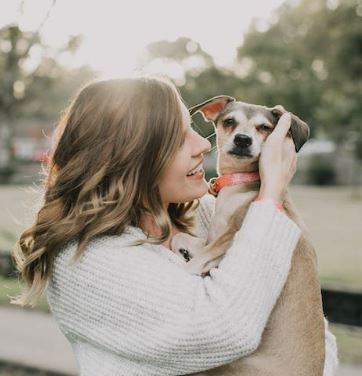
Marissa Delotta, 36, from Dayton, Ohio, is the creative force behind Roverboard.com, a beloved online destination for dog lovers. As a dedicated mom and canine enthusiast, Marissa combines her family experiences with her love for dogs to offer a platform where dog owners can exchange tips, heartwarming stories, and advice. Her website has become a vibrant community for sharing the joys of dog parenting. In her free time, Marissa enjoys exploring dog parks with her family and volunteering at local animal shelters.


